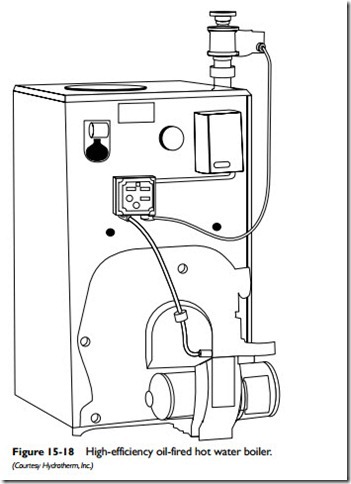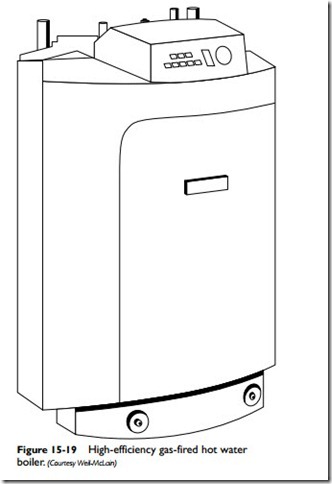High-Efficiency Boilers
The development of the high-efficiency (condensing) boiler came about as a direct reaction to the oil crisis in the 1970s. Higher heat- ing oil costs and the public’s desire for greater fuel efficiency resulted in the development of boilers with a much higher efficiency than the conventional ones. Using the ASFUE ratings, the conventional boilers had a fuel efficiency in the 60 percent range, whereas the new high- efficiency boilers have a fuel efficiency rating of 85 percent or higher.
A high-efficiency boiler vents its combustion gases in PVC pipe through a sidewall instead of the chimney. The boiler also requires an induced-draft fan (power vent) and an outside source air-intake for combustion air. Typical high-efficiency (condensing) oil-fired and gas-fired hot water (hydronic) boilers are illustrated in Figures 15-18 and 15-19.
Steam Boiler Valves, Controls, and Accessories
The boilers used in steam heating systems are fitted with a variety of devices designed to ensure the safe and proper operation of the boiler. These boiler valves, controls, and accessories can be divided by function into two basic categories: (1) indicating or measuring devices, and (2) controlling devices. Sometimes both functions are combined in a single unit.
Steam boilers operate under high pressures and temperatures. To avoid serious injury from scalding steam or water, never begin any service or repairs shutoff before taking the following precautions:
• Wait for the boiler to cool down to 80°F (27°C) or more.
• Wait for the boiler pressure to drop to 0 psi (0 bar).
• Disconnect the electrical power before making any electrical connections.
• Connect a temporary drain pipe to the control opening to pre- vent exposure to steam discharge.
Principal Steam Boiler Valves, Controls, and Accessories
A steam boiler should be equipped with the following valves, controls, and accessories:
• Water level gauge: A gauge that measures the water level inside the boiler.
• Low-water cutoff: A device that automatically switches off the burner if the boiler water level becomes too low for safe operation.
• Pressure gauge: A gauge that measures the operating pressure inside the boiler.
• Safety relief valve: A valve that discharges excess steam when boiler pressure exceeds the maximum pressure limit on the valve.
• High-pressure limit switch: A switch that shuts off the burner when the boiler pressure exceeds a preset level.
• Condensate pump: A small pump used to return conden- sate to the boiler.
Indicating devices include water gauges, pressure gauges, and similar types of devices that provide information about the operating conditions in the boiler. They are used to indicate temperatures, pressures, or water levels that fall outside the design limits of the boiler. Controlling devices include boiler equipment designed to cause changes in these conditions. For example, pressure relief valves are used to relieve excess pressure in the boiler.

